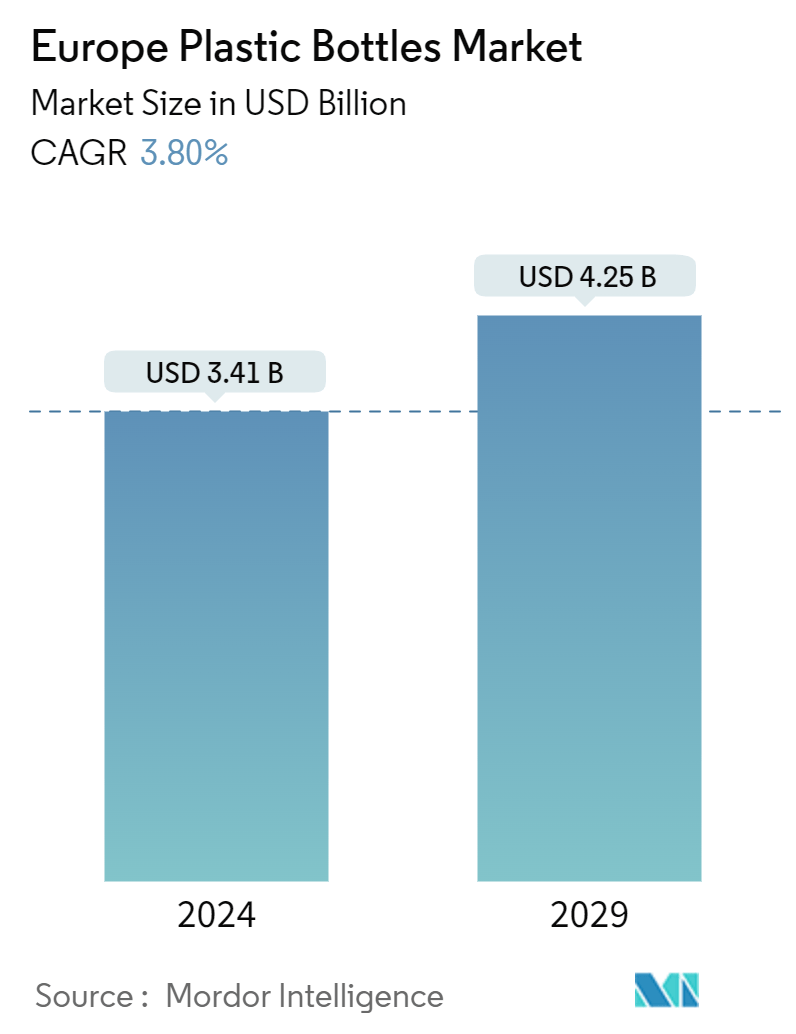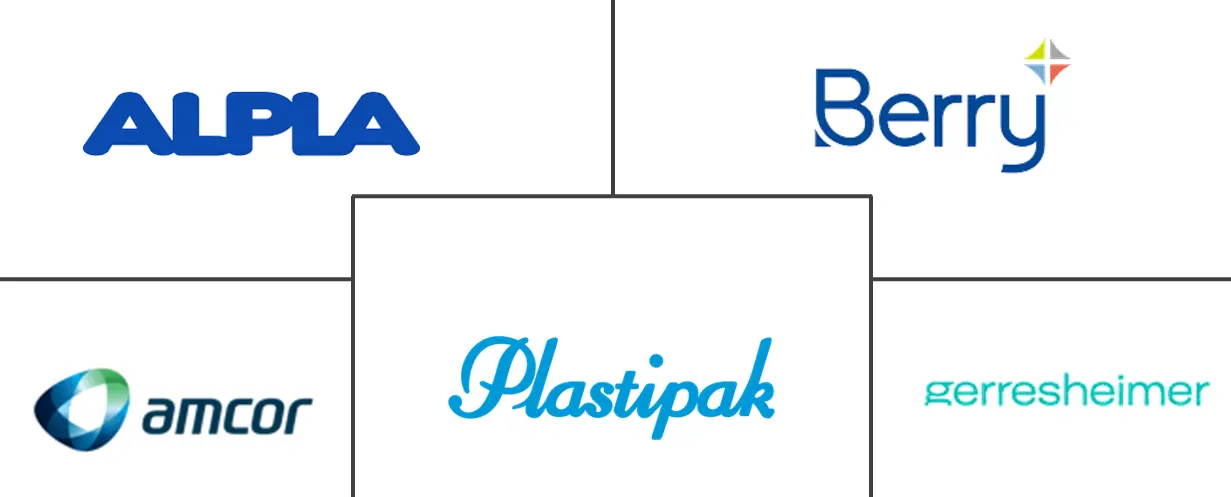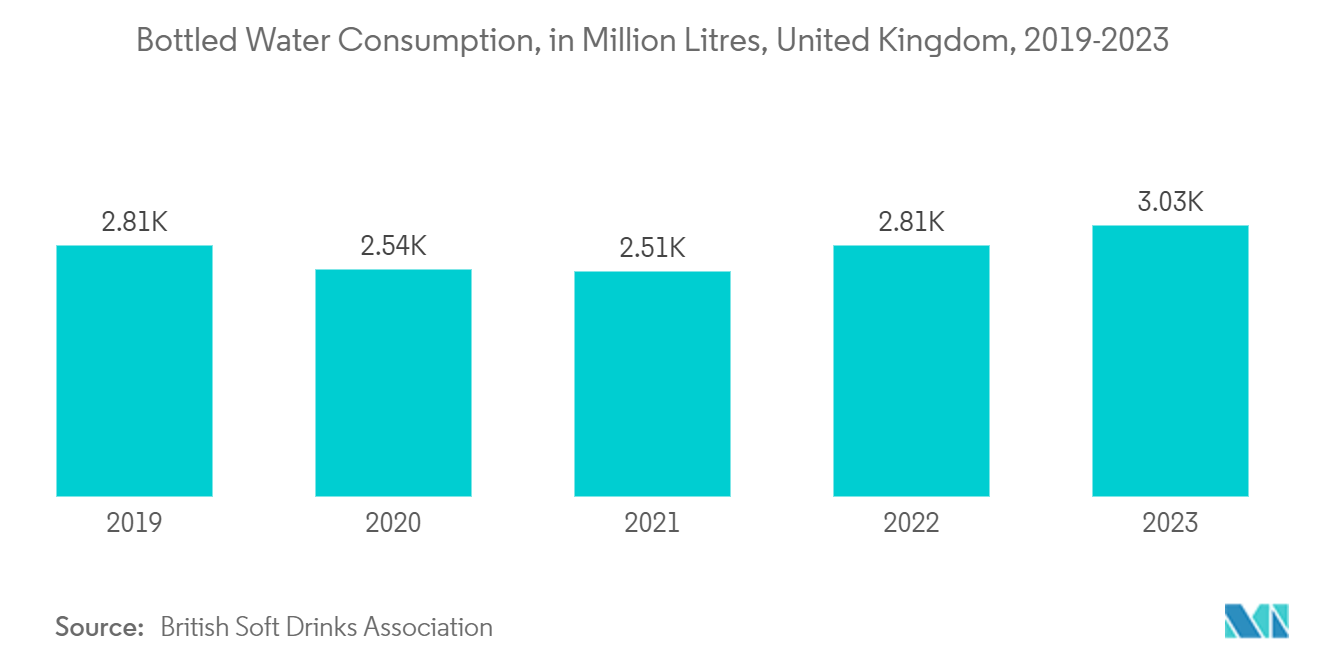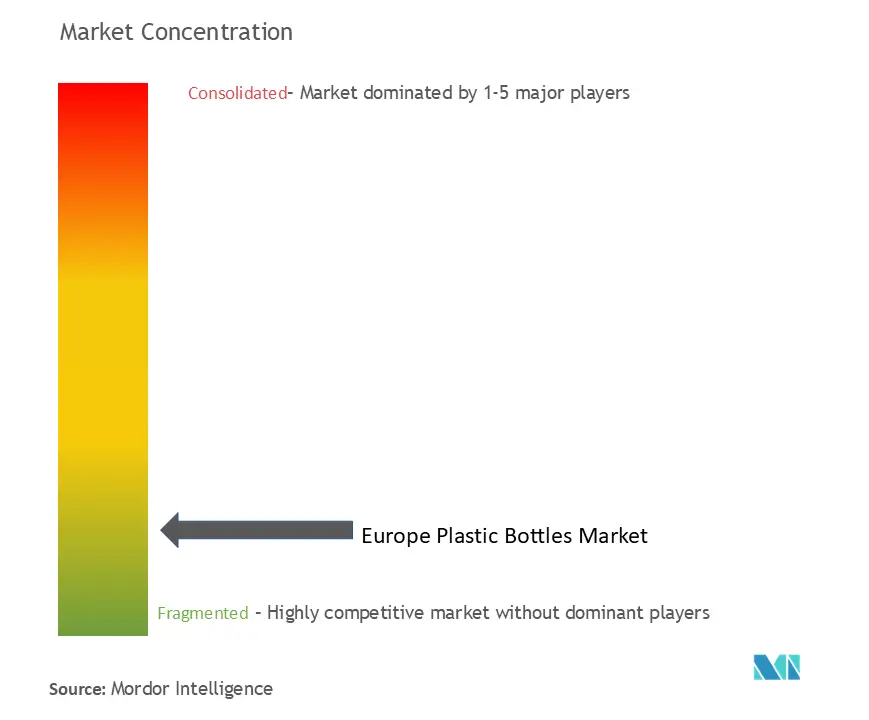Europe Plastic Bottles Market Size

| Study Period | 2019 - 2029 |
| Base Year For Estimation | 2023 |
| Market Size (2024) | USD 3.41 Billion |
| Market Size (2029) | USD 4.25 Billion |
| CAGR (2024 - 2029) | 3.80 % |
| Market Concentration | Medium |
Major Players
*Disclaimer: Major Players sorted in no particular order |
Europe Plastic Bottles Market Analysis
The Europe Plastic Bottles Market size is estimated at USD 3.41 billion in 2024, and is expected to reach USD 4.25 billion by 2029, growing at a CAGR of 3.80% during the forecast period (2024-2029). In terms of production volume, the market is expected to grow from 3.78 million tonnes in 2024 to 4.5 million tonnes by 2029, at a CAGR of 3.55% during the forecast period (2024-2029).
- The plastic bottles market in Europe is characterized by products primarily made from polyethylene terephthalate, polypropylene, and polyethylene. These materials dominate the packaging landscape due to their lightweight and durable nature and cost-effectiveness, making them a preferred choice for manufacturers. Given the global reliance on packaged foods and beverages, these factors set the stage for a significant impact on the European plastic bottles market in the coming years.
- The rising adoption of plastic is closely linked to its lightweight properties. This advantage not only conserves energy during transportation but also curtails emissions. The weight benefit of plastic becomes even more pronounced when compared with heavier alternatives like glass, which demand more transportation trips.
- Among the various materials used to craft plastic bottles, polyethylene terephthalate (PET) is favored for its durability, versatility, and cost-efficiency. As Europe's food, beverage, and pharmaceutical industries expand and innovate, the demand for plastic packaging, especially PET bottles, rises in tandem. Moreover, the industry's trend of introducing new beverages in diverse flavors and packaging styles further bolsters the demand for rigid plastic bottles.
- The beverage segment, particularly, is heavily reliant on plastic bottles, driven by the consistent demand for bottled water and non-alcoholic drinks. Consumers gravitate toward bottled water for its perceived purity, often avoiding potentially contaminated tap water, and they appreciate the convenience and portability it offers.
- Addressing environmental concerns, a study by the European Commission highlighted the prevalence of PET bottles and their lids in ocean debris. In response, the European Council implemented stringent regulations aiming to reduce the use of single-use plastics and set ambitious recycling targets.
- The foundational pillars for material circularity include removal, redesign, reuse, and alternative models. The overarching goal is to minimize material use, eliminate surplus, and incorporate recyclable components. While there is ongoing innovation for alternative packaging solutions, a crucial focus remains on ensuring existing materials can be effectively collected, recycled, and/or refilled, thereby promoting a circular packaging economy.
- One increasingly favored strategy in this endeavor is the rise of deposit return systems (DRS). When effectively designed, Deposit Refund Systems (DRS) can significantly boost collection rates of beverage packaging in the non-alcoholic beverages industry. Thus, the expansion of efficient DRS across Europe becomes paramount, a feat achievable only with backing from the European Commission. This urgency was underscored by a joint press release from UNESDA, in collaboration with Zero Waste Europe and Natural Mineral Waters Europe (NMWE), in October 2021. They urged the European Commission to establish minimum standards for new Deposit Refund Systems (DRS) in the revision of the EU Packaging and Packaging Waste Directive.
- In a testament to this trend, Europe's Brookfield Drinks unveiled a 100% Prevented Ocean Plastic bottle in March 2024. Part of the company’s NEO WTR range, this bottle was set to hit the shelves in 250 Tesco superstores. Brookfield Drinks' initiative is a notable achievement, surpassing major soft drink brands by launching a new spring water range in the industry's first fully recycled ocean-bound plastic bottle, complete with a recyclable cap and label.
Europe Plastic Bottles Market Trends
Strong Demand From the Beverage Segment Driving the Market
- The beverage segment is propelling significant growth in the market studied. As plastic bottles gain traction in this segment, manufacturers are expanding their focus beyond beverages to cater to diverse end-use industries. Lightweight packaging, due to its economic efficiency and environmental benefits, has become a cornerstone of the packaging industry. The lightweight nature of plastic bottles and containers not only curtails energy consumption during transportation but also translates to reduced fuel usage, lower carbon emissions, and cost savings for distributors and retailers. This trend is particularly significant as companies strive to meet stringent environmental regulations and consumer demand for sustainable practices.
- According to the 2024 Annual Report by the British Soft Drink Association, the United Kingdom consumed 3,027 million liters of bottled water in 2023, with a staggering 95.2% of that volume in plastic bottles. As bottled water consumption continues its upward trajectory, the beverage segment’s demand for rigid plastic bottles is poised to escalate. This increase in demand is driven by increased consumer preferences for convenience and portability, as well as the growing awareness of the health benefits associated with bottled water.
- Plastic bottles dominate the UK beverage market, owing to their cost-effectiveness and barrier properties. They account for 68% of soft drink consumption, 53% of carbonated drinks, 95% of dilutables, and 42% of sports and energy drinks, as per findings from the British Soft Drink Association. The versatility and durability of plastic bottles make them an ideal choice for various beverage types, ensuring product safety and extending shelf life. Additionally, advancements in plastic bottle manufacturing technology have enhanced their appeal by improving their recyclability and reducing their environmental footprint.
- The European plastic bottles market is witnessing a pronounced shift toward sustainability. Initiatives include adopting sustainable raw materials like bioplastics and incorporating recycled content into product lines. With the Single-Use Plastic Directive setting ambitious targets of 25% recycled content by 2025 and 30% by 2030, the industry is on the brink of transformation. In response, manufacturers are channeling investments into recycling technologies, underscoring their commitment to sustainability. These efforts are not only driven by regulatory requirements but also by the increasing consumer demand for eco-friendly products. Companies that successfully integrate sustainability into their operations are likely to gain a competitive edge in the market.
- As beverage consumption surges, so does the demand for plastic bottles and containers across the board, be it for bottled water, carbonated drinks, or milk. Highlighting this trend, Germany's per capita soft drink consumption jumped from 114.7 liters in 2020 to an anticipated 124.9 liters in 2023, showcasing the nation's strong demand for plastic packaging. This growth is indicative of broader trends in the European market, where convenience and lifestyle changes are driving increased consumption of packaged beverages. The rising demand for plastic packaging solutions presents both opportunities and challenges for manufacturers, driving the need for innovation with the imperative of sustainability.

Germany Expected to Witness Significant Market Growth
- Driven by advancements from both solution providers and end users, Germany is increasingly adopting plastic packaging solutions. The region's flexible packaging companies have notably benefited from the esteemed consumer perception of "Made in Germany" products. This perception has created a competitive edge for local manufacturers, enhancing their market presence and driving demand for innovative packaging solutions.
- In response to the plastic packaging industry's challenges, the German government has enacted stringent regulations. These regulations aim to reduce environmental impact and promote sustainable practices within the industry. While PET bottles are ubiquitous across various segments, polyethylene (PE) bottles lead sales in beverages, cosmetics, sanitary products, and detergents. The regulatory framework has also encouraged companies to invest in research and development, fostering advancements in recyclable and biodegradable packaging materials.
- As cosmetic consumption surges and plastic packaging technology continues to innovate, the market stands on the brink of significant growth. Plastic's lightweight nature, cost-effectiveness, and hygienic properties make it especially ideal for cosmetics, particularly those with shorter shelf lives. PET plastic bottles, being transparent, airtight, easily moldable, and possessing good compressive strength, are not only enhancing the visual appeal of high-end cosmetics but also signaling a bright future for this segment. The ongoing innovations in packaging design and materials are expected to further boost the market, catering to the evolving preferences of consumers and brands alike.
- The German beauty and personal care market is not only robust but also experiencing rapid growth. As reported by Cosmetics Europe, Germany led the European cosmetics market with a significant share in 2023, reaching a valuation of USD 17.36 billion. This thriving luxury cosmetics market in Germany is driving innovations, pushing cosmetic bottle designs toward more aesthetic and appealing forms. The emphasis on premium packaging solutions reflects the growing consumer demand for high-quality and visually attractive products, further propelling the market's expansion.

Europe Plastic Bottles Industry Overview
The European plastic bottles market is fragmented due to the presence of several market players. Some major players are Amcor Group GmbH, Alpla Group, Berry Global Inc., Gerresheimer Inc., and Plastipak Holdings Inc. The players are expected to leverage the opportunities posed by the growth of several end-user verticals and are innovating to expand their market presence.
- May 2024: ALPLA, a leading company in plastic packaging, unveiled a new recyclable wine bottle crafted from polyethylene terephthalate (PET). This innovative packaging aims to slash carbon footprints by as much as 50% and offer potential cost savings of up to 30%. Currently, the bottles, offered in 750ml and one-liter sizes, are being used by Wegenstein, an Austrian wine producer and the solution's pilot customer and development partner.
- November 2023: German water bottle company Air Up GmbH teamed up with specialty material firm Eastman to launch a fresh line of reusable bottles. Targeted at the European market, this new bottle range utilizes Eastman’s Tritan Renew material, boasting 50% certified recycled content, leveraging Eastman’s advanced molecular recycling technology. This innovative technology deconstructs hard-to-recycle plastics into their fundamental molecular components, enabling their repurposing into new polymers. The collaboration led to Air Up’s Generation Two bottles featuring Tritan Renew, offered in two convenient sizes: 600ml and one liter. These lightweight, durable bottles are crafted at production facilities located within the European Union.
Europe Plastic Bottles Market Leaders
-
Amcor Group GmbH
-
Gerresheimer AG
-
ALPLA Group
-
Berry Global Inc.
-
Plastipak Holdings Inc.
*Disclaimer: Major Players sorted in no particular order

Europe Plastic Bottles Market News
- June 2024: Cherwell Laboratories, a manufacturer and supplier of cleanroom microbiology solutions to pharmaceutical and related industries across the United Kingdom and Europe, introduced a new Redipor Plastic Bottle prepared media range in response to a request from a large pharmaceutical company for support in meeting its sustainability targets. The new terminally sterilized plastic bottled media products have been developed and launched by Cherwell to offer a more environmentally friendly and cost-effective alternative to glass bottled media for use in sterile pharmaceutical manufacturing.
- January 2024: In response to Hungary's newly introduced deposit return scheme, Petainer and Oonly launched their inaugural refillable PET bottle for mineral water in Hungary. Their aim is to promote circularity within the nation's beverage industry. In contrast to a refillable 1.5L glass bottle, the Oonly bottle weighs just 106g and utilizes about 4.24g of material per cycle, whereas the glass counterpart weighs roughly 800g. This reduced weight is believed to facilitate more 'vigorous' washing between cycles.
Europe Plastic Bottles Market Report - Table of Contents
1. INTRODUCTION
- 1.1 Study Assumptions and Market Definition
- 1.2 Scope of the Study
2. RESEARCH METHODOLOGY
3. EXECUTIVE SUMMARY
4. MARKET INSIGHTS
- 4.1 Market Overview
-
4.2 Industry Attractiveness - Porter's Five Forces Analysis
- 4.2.1 Bargaining Power of Suppliers
- 4.2.2 Bargaining Power of Consumers
- 4.2.3 Threat of New Entrants
- 4.2.4 Threat of Substitute Products
- 4.2.5 Intensity of Competitive Rivalry
- 4.3 Industry Value Chain Analysis
5. MARKET DYNAMICS
-
5.1 Market Drivers
- 5.1.1 Increasing Adoption of Lightweight Packaging Methods
- 5.1.2 Changing Demographic and Lifestyle Factors
-
5.2 Market Restraints
- 5.2.1 Growing Environmental Concerns Over the Use of Plastics
-
5.3 Trade Scenario
- 5.3.1 EXIM Data
- 5.3.2 Trade Analysis (Top 5 Import-Export Countries, Price Analysis, and Key Ports, Among Others)
- 5.4 Trade Analysis (Top 5 Import-Export Countries, Price Analysis, and Key Ports, Among Others)
- 5.5 Industry Regulations, Policies, and Standards
- 5.6 Technology Landscape
-
5.7 Pricing Trend Analysis
- 5.7.1 Plastic Resins (Current Pricing and Historic Trends)
6. MARKET SEGMENTATION
-
6.1 By Resin
- 6.1.1 Polyethylene (PE)
- 6.1.2 Polyethylene Terephthalate (PET)
- 6.1.3 Polypropylene (PP)
- 6.1.4 Other Resin Types (Polystyrene, PVC, Polycarbonate, etc.)
-
6.2 By End-use Industries
- 6.2.1 Food
- 6.2.2 Beverage
- 6.2.2.1 Bottled Water
- 6.2.2.2 Carbonated Soft Drinks
- 6.2.2.3 Alcoholic Beverages
- 6.2.2.4 Juices & Energy Drinks
- 6.2.2.5 Other Beverages
- 6.2.3 Pharmaceuticals
- 6.2.4 Personal Care & Toiletries
- 6.2.5 Industrial
- 6.2.6 Household Chemicals
- 6.2.7 Paints & Coatings
- 6.2.8 Other End-use Industries
-
6.3 By Country***
- 6.3.1 France
- 6.3.2 Germany
- 6.3.3 Italy
- 6.3.4 United Kingdom
- 6.3.5 Spain
- 6.3.6 Poland
7. COMPETITIVE LANDSCAPE
-
7.1 Company Profiles*
- 7.1.1 Amcor Group GmbH
- 7.1.2 Gerresheimer AG
- 7.1.3 Plastipak Holdings Inc.
- 7.1.4 ALPLA Group
- 7.1.5 Berry Global Inc.
- 7.1.6 Alpha Packaging Inc.
- 7.1.7 Graham Packaging
- 7.1.8 Resilux NV
- 7.1.9 Greiner Packaging International GmbH
- 7.1.10 Comar LLC
- 7.2 Heat Map Analysis
- 7.3 Competitor Analysis - Emerging vs. Established Players
8. RECYCLING & SUSTAINABILITY LANDSCAPE
9. FUTURE OF THE MARKET
** Subject To AvailablityEurope Plastic Bottles Industry Segmentation
The scope of the study characterizes the plastic bottles market based on the raw materials of the product, such as PP, PE, PET, and other raw materials used across various end-user industries, including food, pharmaceuticals, beverages, cosmetics, and toiletries, across various countries. The research also examines underlying growth influencers and significant industry vendors, all of which help support market estimates and growth rates throughout the anticipated period. The market estimates and projections are based on the base year factors and arrived at through top-down and bottom-up approaches.
The European plastic bottles market is segmented by resin (polyethylene (PE), polyethylene terephthalate (PET), polypropylene (PP), and other resin types), end-use industries (food, beverages (bottled water, carbonated soft drinks, alcoholic beverages, juices and energy drinks, and other beverages), pharmaceuticals, personal care and toiletries, household chemicals, paints and coatings, and other end-use industries), and country (France, Germany, Italy, United Kingdom, Spain, Poland, Nordic, and Rest of Europe). The market sizing and forecasts are provided in terms of value (USD) and volume (tonnes) for all the above segments.
| By Resin | Polyethylene (PE) | |
| Polyethylene Terephthalate (PET) | ||
| Polypropylene (PP) | ||
| Other Resin Types (Polystyrene, PVC, Polycarbonate, etc.) | ||
| By End-use Industries | Food | |
| Beverage | Bottled Water | |
| Carbonated Soft Drinks | ||
| Alcoholic Beverages | ||
| Juices & Energy Drinks | ||
| Other Beverages | ||
| Pharmaceuticals | ||
| Personal Care & Toiletries | ||
| Industrial | ||
| Household Chemicals | ||
| Paints & Coatings | ||
| Other End-use Industries | ||
| By Country*** | France | |
| Germany | ||
| Italy | ||
| United Kingdom | ||
| Spain | ||
| Poland |
Europe Plastic Bottles Market Research FAQs
How big is the Europe Plastic Bottles Market?
The Europe Plastic Bottles Market size is expected to reach USD 3.41 billion in 2024 and grow at a CAGR of 3.80% to reach USD 4.25 billion by 2029.
What is the current Europe Plastic Bottles Market size?
In 2024, the Europe Plastic Bottles Market size is expected to reach USD 3.41 billion.
Who are the key players in Europe Plastic Bottles Market?
Amcor Group GmbH, Gerresheimer AG, ALPLA Group, Berry Global Inc. and Plastipak Holdings Inc. are the major companies operating in the Europe Plastic Bottles Market.
What years does this Europe Plastic Bottles Market cover, and what was the market size in 2023?
In 2023, the Europe Plastic Bottles Market size was estimated at USD 3.28 billion. The report covers the Europe Plastic Bottles Market historical market size for years: 2019, 2020, 2021, 2022 and 2023. The report also forecasts the Europe Plastic Bottles Market size for years: 2024, 2025, 2026, 2027, 2028 and 2029.
Europe Plastic Bottles Industry Report
Statistics for the 2024 Europe Plastic Bottles market share, size and revenue growth rate, created by Mordor Intelligence™ Industry Reports. Europe Plastic Bottles analysis includes a market forecast outlook for 2024 to (2024to2029 and historical overview. Get a sample of this industry analysis as a free report PDF download.



